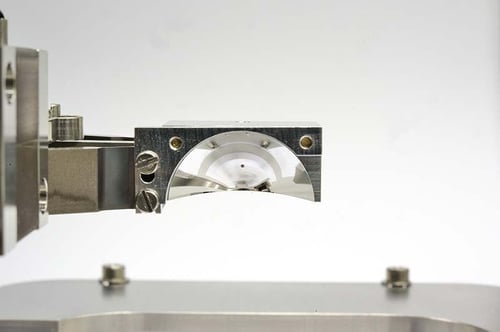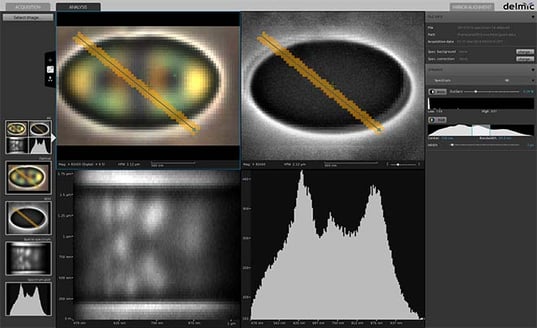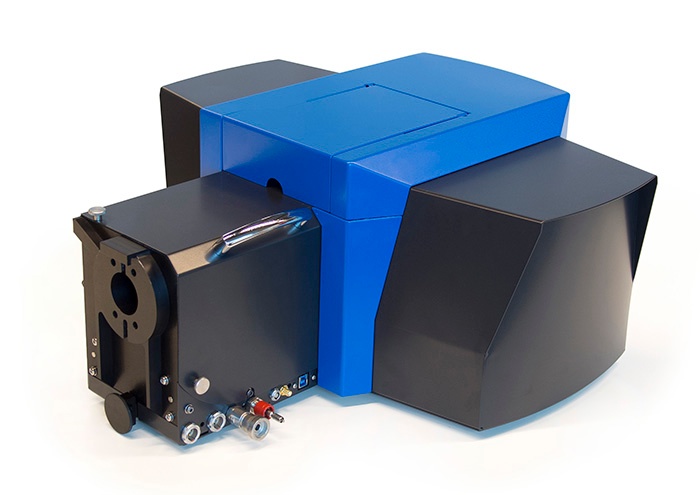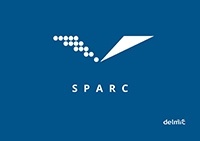This is why DELMIC has developed the SPARC cathodoluminescence (CL) system, which is designed to fit on a scanning electron microscope and detect CL emission using any of available six imaging modes. The SPARC is unmatched in terms of its unique features and high performance, and is recommended for any researcher that wants to keep pace with the competitive scientific community.
Below, we outline the four main reasons why the SPARC system is the best choice for researchers in geosciences, materials science, and nanophotonics.
1. Innovative features
The SPARC was developed in 2011 by the Photonic Materials Group at AMOLF as the first (and to date, only) cathodoluminescence detection system that can perform angle-resolved imaging in support of their pioneering research in nanophotonics. The direction in which light is emitted often contains valuable information on how an object emits and scatters light at the nanoscale, and can be an important performance metric for antenna structures.
The SPARC is the only system that can be retrofitted on an existing SEM which can perform time-resolved cathodoluminescence detection. This enables ultrafast data collection using a nanosecond pulsed electron beam. Novel research attests to the potential of time-resolved CL spectroscopy for investigations in in nanophotonics, quantum optics, semiconductor optoelectronics, biology, geology, photovoltaics, photocatalysis, and other areas.
The angle-resolved mode allows the SPARC to offer another unique imaging mode: polarimetry. This can be used for reconstructing the polarization state of CL for different emission angles. When combined with angle-resolved imaging, it allows for the analysis of emission mechanisms of nanostructured devices.
However, the SPARC offers more commonly-used imaging modalities as well. These include:
- Intensity mapping/imaging: conducting rapid inspection of large areas using a photomultiplier tube
- (Hyper) spectral imaging: obtaining a spectrum for every electron beam position using a Czerny-Turner spectrograph

Image: quartz in sandstone, imaged using a photomultiplier tube with the intensity mapping imaging mode.
DELMIC’s SEM CL system is thus extremely versatile and can be adapted to a broad range of research fields. This leads us to our second point:
2. Flexibility
Above, we have described the many imaging modes available to the researcher using the SPARC system, a number of which are not possible with any other microscope. The SPARC offers even more features which make it highly flexible to meet the needs of rapidly evolving scientific research.
First of all, the SPARC’s open design uses optical modules that can easily be upgraded. Our customers can therefore integrate new components such as filters, additional spectrographs or cameras, optical plates, and polarizers to meet their specific needs. Researchers can thus stay up to date with innovations and new discoveries in their research. This also allows the system to be used for multiple applications at a single research facility, without any compromise on the quality of the data acquired.
The modular design of the SPARC therefore means that dedicated systems can be developed to most effectively collect the specific data that is needed. For example, one research facility might require a system which can detect light in the UV range, and will thus use UV filters. Geologists tend to want to carry out fast intensity mapping using a specific photomultiplier tube. All of this is possible with the modular SPARC system.
The mounting of the hardware is done on a vacuum port which enables it to be fitted on any SEM from a major manufacturer while being minimally invasive. The seamless integration between the SPARC system and the SEM enables the correlation of cathodoluminescence imaging with different SEM detection modalities such as EBSD, EBIC and BSD. This enables full in-situ characterization of your sample.
In addition to being flexible, the ideal SEM cathodolumiscence system also needs to make use of the highest quality components to ensure accurate measurements. This leads us to our third point:
3. High-performance
The SPARC is made of only the best quality components for accurate measurements. This ensures that every photon counts: all collection and detection optics are free-space coupled ensuring maximum collection efficiency and a high photon yield.
The system also makes use of peltier-cooled cameras, which minimize vibrations and make the process of data collection much more efficient for the researcher. A cryostat is thus no longer needed, which eliminates the cumbersome process of regularly refilling it with liquid nitrogen. This leaves time for what truly matters: data collection and analysis.
 Image: the SPARC's fully retractable motorized mirror stage.
Image: the SPARC's fully retractable motorized mirror stage.
The mirror is made of melt-spun aluminium - a unique aluminium with a tiny grain size - which ensures maximum flatness of the mirror. This enhances reflectivity, reduces artifacts, and minimizes measurement time. The mirror has an ultraflat surface which increases the photon yield and ensures high-quality angle-resolved imaging.
The mirror is mounted on a motorized high-precision stage which allows reproducible alignment throughout the various processes of your research. This enables the precise, quantitative comparison of different measurements, ultimately making the SPARC a user-friendly technology. Hence, our final point:
4. Ease-of-use
In spite of being able to carry out complex and highly accurate measurements down to the nanoscale, the SPARC remains a tool which is easy to use, thanks to the intuitive user interface and the continuous support offered by DELMIC's engineers.
The system comes with open-source software that has been specially developed for the SPARC at DELMIC’s headquarters. ODEMIS is easy to use and aids in the entire process of data collection: through the software, you perform the alignment of your sample, acquisition, and analysis of results.
During acquisition, the software ensures:
- The simultaneous acquisition of SEM and optical images
- Drift correction
- The possibility to obtain images over any sized grid with any number of pixels
Results can immediately be analyzed through the software. There are several possibilities to choose from depending on your research subject:
- Visualize 3D CL data as a 2D map or pixel-by-pixel graph
- Visualize 2D slices for 3D data sets with adjustable integration limits
- Perform immediate polar plotting for angle-resolved imaging
- Overlay the SEM and spectral images for spectral imaging
- Perform background subtraction
- Obtain correction files to immediately obtain clean data
- Perform automated peak fitting
- Transfer files to MATLAB or other programs for detailed analysis
Advanced users can also access the Python scripting interface to add functionality and carry out unique measurements. This software is continuously being developed further to ensure that our future and existing users can carry out their research in the most effective way.
 Image: a screenshot of the SPARC's open-source software, ODEMIS.
Image: a screenshot of the SPARC's open-source software, ODEMIS.
More generally, DELMIC is committed to ensuring that users are always able to benefit from a well-functioning, high-performance SEM cathodoluminescence detection system.
Dr. Ruggero Verre of Chalmers University of Technology is making use of the SPARC for research on plasmonic nanoantennas. This project requires a beam of electrons to probe the material at the nanoscale and the detection of the light that is emitted as a result. This research further benefits from the use of angle-resolved imaging - solely offered by the SPARC - to map the angle of the emission.
On his experience as a SPARC user, Dr. Verre says: "DELMIC has developed an integrated solution and provided excellent one-to-one support which has been of help to our research.”
If you want to learn more, download the brochure for the SPARC below:
.png)







